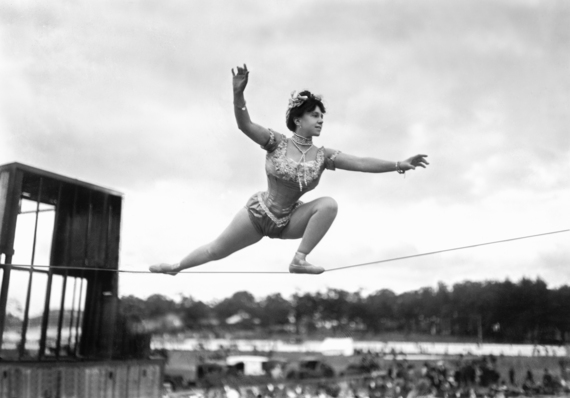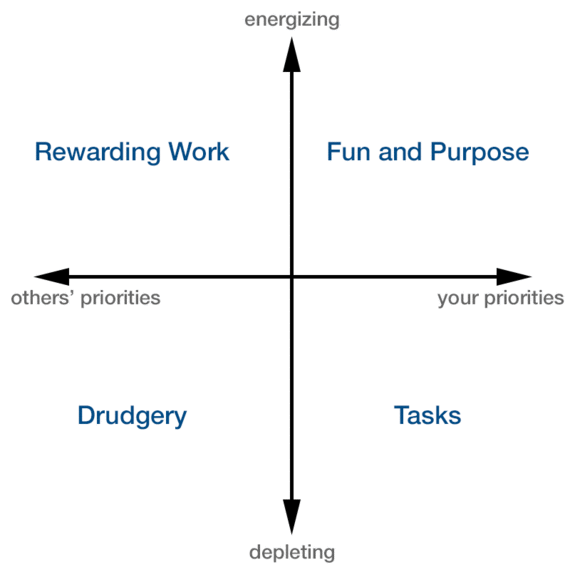Who are we kidding? There's no separation between "work" and "life." As a freelance writer, my life and work are indistinguishable. The anxieties—article deadlines, family drama, leg waxing—are thrown into one homogeneous pool of chronic stress. Work-life balance must be simpler for nine-to-fivers, right? A quick work day bookended by an hour-long commute pumping the clutch in stop-and-go.
Work-life balance is hard no matter who you are, or how long your commute. Why? Because work-life balance is a big hoax. The more we believe in it, the more miserable we become.
"Work" and "life" aren't binary. "Balance" is dynamic, not static. And "life" is much more complex than "non-work."
Work-life balance is a fantasy, and believing in it is holding us back from true happiness. Here's what's wrong:
Fallacy 1: Balance Means Equal
Here's the first myth: Your existence has two components: "work" and "life." Not true.
Stew Friedman says it beautifully in this piece for Harvard Business Review, "The idea that 'work' competes with 'life' ignores that 'life' is actually the intersection and interaction of four major domains: work, home, community, and the private self."
Finding balance isn't just equalizing "life" and "work"—it varies, sometimes on a daily basis. Balance means shifting with the priorities of the day, week, month and year. And that's okay.
Fallacy 2: Balance is Attainable
We wrongly believe that work-life balance is something you can "achieve." This idea makes us miserable. Balance isn't static—it's a state of constant flux.
Dan Thurmon uses the example of a handstand. In his Tedx Talk, he does a handstand onstage. And it's damn good one, too. But if you look closely, he's moving. Little to the left, little to the right...he's making microadjustments to keep himself upside down. He's balanced, but not static. "It's a process of constant adjustments, decisions, corrections, responding to opportunities and challenges," Thurmon says. Basically you're about to fall over at any moment. And that's normal.
Thurmon says we have to stop thinking there will be a moment "where it all evens out." Juggling work, family, and self-fulfillment involves constant adjustments and priority shifts.
Fallacy 3: We Must Accomplish More in Less Time
A "balanced" day doesn't mean you accomplish more in less time. A lot of work-life balance peddlers preach super-human productivity. The key is not to cram more things into your day, but rather evaluate what matters and reallocate time to those things. What's beautiful, Thurmon explains, is that by slowing down you feel like you have more time, not less. "It's not about increasing your pace, because life speeds right up with you. Ironically, by slowing down even a little, you begin to notice those spaces, those opportunities, and they expand for you."
Fallacy 4: Achievement Will Make Us Happy
At the core of work-life balance are two concepts: achievement and enjoyment, writes Jim Bird, an author and speaker on work-life balance. "We assume that if we seek achievement, enjoyment will follow automatically. But it doesn't," he said in
. "If you try to get all the value from one side, all the value disappears." Feelings of purpose and balance flow from experiencing both accomplishment and joy—simultaneously, separately, or however—at some point in your day.
What's my purpose in life? I just want to achieve something today and I want to enjoy something today. And if I do both of those things today, I'm going to have a pretty good day. And if I do both of those things every day, for the rest of my life... I'm going to have a pretty good life.
-Jim Bird
So, where is the intersection of enjoyment and achievement? Behold Lauren Bacon's "Balance Matrix." Using the x-axis to map priorities and the y-axis to measure energy, she's created four quadrants where the upper right ("Fun and Purpose" quadrant) is the sweet spot.
Her argument is that instead thinking that fun moments are only a reward for suffering through the drudgery of work, we can shift our perspective to find reward in the work. "Your work-that-doesn't-feel-like work is precisely the point of your life," she writes. "Maybe you can't quit your day job or fire your kids...but a little tweaking can do wonders."
Fallacy 5: You Can't Have It All
You can't have your cake and eat it too, right? Wrong. You can have all the cakes and all the eating. And here's how: stop believing in the work-life balance hoax. Instead, make peace with the flux. Know that some days will feel more balanced than others. Balance is not a state of being, it's a fulcrum: the dynamic middle point of push and pull.
To make it easier to navigate, Jim Bird says to divide your world into four main quadrants—work, family, friends, and self—and try to find achievement and enjoyment in each quadrant daily. For me, achievement and enjoyment sometimes happen at the same time ("Boom! I just smashed that article draft!"), sometimes they happen separately ("Thank god I finished that web copy. Now let's play kickball.") What's important is the movement—that soft sway on the fulcrum. Balance is the little daily efforts to avoid tipping.
As Stew Friedman writes, "One can cultivate a life in which values, actions, social contribution, and personal growth exist in harmony...not every single day—that's the impossible myth of 'work-life balance'—but over the course of a lifetime."
This is a life's work. But don't let that intimidate you. You can have more balance today. Right now. It's a mind set. It's a daily practice. You're capable in this very moment.
photo by Frederick W. Glasier courtesy of RadioSRQ
Support HuffPost
Our 2024 Coverage Needs You
Your Loyalty Means The World To Us
At HuffPost, we believe that everyone needs high-quality journalism, but we understand that not everyone can afford to pay for expensive news subscriptions. That is why we are committed to providing deeply reported, carefully fact-checked news that is freely accessible to everyone.
Whether you come to HuffPost for updates on the 2024 presidential race, hard-hitting investigations into critical issues facing our country today, or trending stories that make you laugh, we appreciate you. The truth is, news costs money to produce, and we are proud that we have never put our stories behind an expensive paywall.
Would you join us to help keep our stories free for all? Your contribution of as little as $2 will go a long way.
Can't afford to donate? Support HuffPost by creating a free account and log in while you read.
As Americans head to the polls in 2024, the very future of our country is at stake. At HuffPost, we believe that a free press is critical to creating well-informed voters. That's why our journalism is free for everyone, even though other newsrooms retreat behind expensive paywalls.
Our journalists will continue to cover the twists and turns during this historic presidential election. With your help, we'll bring you hard-hitting investigations, well-researched analysis and timely takes you can't find elsewhere. Reporting in this current political climate is a responsibility we do not take lightly, and we thank you for your support.
Contribute as little as $2 to keep our news free for all.
Can't afford to donate? Support HuffPost by creating a free account and log in while you read.
Dear HuffPost Reader
Thank you for your past contribution to HuffPost. We are sincerely grateful for readers like you who help us ensure that we can keep our journalism free for everyone.
The stakes are high this year, and our 2024 coverage could use continued support. Would you consider becoming a regular HuffPost contributor?
Dear HuffPost Reader
Thank you for your past contribution to HuffPost. We are sincerely grateful for readers like you who help us ensure that we can keep our journalism free for everyone.
The stakes are high this year, and our 2024 coverage could use continued support. If circumstances have changed since you last contributed, we hope you’ll consider contributing to HuffPost once more.
Already contributed? Log in to hide these messages.

